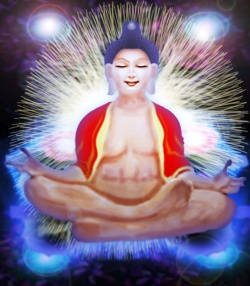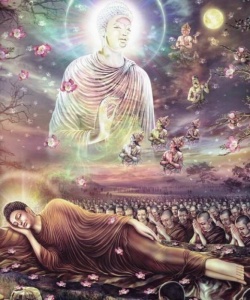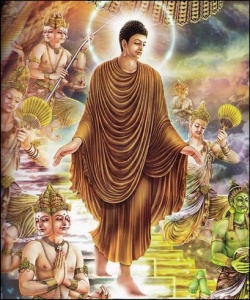Four stages of enlightenment
The four stages of enlightenment in Buddhism are the four progressive stages culminating in full enlightenment as an Arahat.
The four stages are Sotapanna, Sakadagami, Anagami and Arahat. The Buddha referred to people who are at one of these four stages as noble people (ariya-puggala) and the community of such persons within the bhikkhu-sangha as the noble sangha (ariya-sangha).
The teaching of the four stages of enlightenment is a central element of the early Buddhist schools, including the Theravada school of Buddhism, which still survives.
Origins
In the Sutta Pitaka several types of Buddhist practitioners are described, according to their level of attainment. The standard is four, but there are also longer descriptions with more types. The four are the Stream-enterer, Once-returner, Non-returner and the Arahat.
In the Visuddhimagga the four stages are the culmination of the seven purifications. The descriptions are elaborated and harmonized, giving the same sequence of purifications before attaining each of the four paths and fruits.
The Visuddhimagga stresses the importance of prajna, insight into anatta and the Buddhist teachings, as the main means to liberation. Vipassana has a central role in this path. Insight is emphasized by the contemporary Vipassana movement.
Path and Fruit
The Sutta Pitaka classifies the four levels according to the levels' attainments. The Sthaviravada/Theravada tradition, which believes that "progress in understanding comes all at once, 'insight' (abhisamaya) does not come 'gradually' (successively - anapurva)," has elaborated on this classification, describing each of the four levels as a path to be attained suddenly, followed by the realisation of the fruit of the path.
The process of becoming an Arahat is therefore characterized by four distinct and sudden changes, instead of a gradual development. The same stance is taken in the contemporary Vipassana movement, especially the so-called "New Burmese Method".
The ordinary person
An ordinary person or pruthajjana (Pali; Sanskrit: pṛthagjanai.e. pritha : without, and jnana : knowledge) is trapped in the endless cycling of samsara. One is reborn, lives, and dies in endless rebirths, either as a deva, human, animal, male, female, neuter, ghost, deity, divinity, or hellion, or various other entities on different categories of existence.
An ordinary entity has never seen and experienced the ultimate truth of Dharma and therefore has no way of finding an end to the predicament. It is only when suffering becomes acute, or seemingly unending, that an entity looks for a "solution" to and, if fortunate, finds the Dharma.
The four stages of attainment
The Sangha of the Tathagata's disciples (Ariya Sangha) can be described as including four or eight kinds of individuals. There are four [groups of noble disciples) when path and fruit are taken as pairs, and eight groups of individuals, when each path and fruit are taken separately:
(1) the path to stream-entry;
(2) the fruition of stream-entry;
(3) the path to once-returning;
(4) the fruition of once-returning;
(5) the path to non-returning;
(6) the fruition of non-returning;
(7) the path to arahantship;
(8) the fruition of arahantship.
Stream-enterer
The first stage is that of Sotāpanna (Pali; Sanskrit: Srotāpanna), literally meaning "one who enters (āpadyate) the stream (sotas)," with the stream being the supermundane Noble Eightfold Path regarded as the highest Dharma. The stream-enterer is also said to have "opened the eye of the Dharma" (dhammacakkhu, Sanskrit: dharmacakṣus).
A stream-enterer reaches arahantship within seven rebirths upon opening the eye of the Dharma.
Due to the fact that the stream-enterer has attained an intuitive grasp of Buddhist doctrine (samyagdṛṣṭi or sammādiṭṭhi, "right view") and has complete confidence or Saddha in the Three Jewels: Buddha, Dharma, and Sangha, that individual will not be reborn in any plane lower than the human (animal, preta, or in hell).
Once-returner
The second stage is that of the Sakadāgāmī (Sanskrit: Sakṛdāgāmin), literally meaning "one who once (sakṛt) comes (āgacchati)". The once-returner will at most return to the human world one more time. Both the stream-enterer and the once-returner have abandoned the first three fetters. The stream-enterer and once-returner are distinguished by the fact that the once-returner has weakened lust, hate, and delusion to a greater degree. The once-returner therefore has fewer than seven rebirths. They may take place in higher planes but will include rebirth in the human world at most only once more. Once-returners do not have only one more rebirth, as the name suggests, for that may not even be said with certainty about the non-returner who can take multiple rebirths in the five "Pure Abodes".
Non-returner
The third stage is that of the Anāgāmī (Sanskrit: Anāgāmin), literally meaning "one who does not (an-) come (āgacchati)". The non-returner, having overcome sensuality, does not return to human world, or any unfortunate world lower than that after death. Instead, non-returners are reborn in one of the five special worlds in Rūpadhātu called the Śuddhāvāsa worlds, or "Pure Abodes", and there attain Nirvāṇa; Pāli: Nibbana; some of them are reborn a second time in a higher world of the Pure Abodes.
An Anāgāmī has abandoned the five lower fetters, out of ten total fetters, that bind beings to the cycle of rebirth. An Anāgāmī is well advanced.
Arahant
The fourth stage is that of Arahant, a fully awakened person. He has abandoned all ten fetters and, upon death (Sanskrit: Parinirvāṇa, Pāli: Parinibbāna) will never be reborn in any plane or world, having wholly escaped saṃsāra. An Arahant had attained awakening by following the path given by the Buddha. In Theravada the term Buddha is reserved for Siddartha Gautama Buddha, as being the one who discovered the path by himself.


